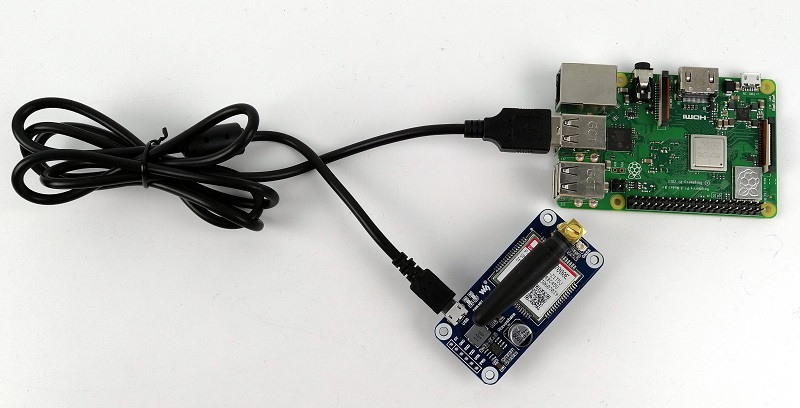Testing Raspberry Pi + SIM7000E NB-IoT Hat + Maxis NB-IoT¶
NB-IoT AT command testing¶
AT command test is basic step to check if NB-IoT is working in good condition.
Prerequisite¶
- Raspberry Pi
- SIM7000E NB-IoT HAT
- MicroUSB Type B Cable
Steps¶
-
Insert and lock the NB-IoT SIM card onto NB-IoT HAT (Back). Connect the NB-IoT HAT to Raspberry Pi Board via USB cable.

-
Run the command below on Raspberry Pi to check availability of HAT. It will show /dev/ttyUSB2 if it exists.
ls /dev/ttyUSB2
-
Run the command below to install screen utility on Raspberry Pi, which allows us to communicate to HAT via UART.
sudo apt-get install screen
-
Run below command to start.
screen /dev/ttyUSB2 115200
-
Type and enter
ATcommand repeatedly until you seeOKin return. -
Run AT commands below to test connection with Internet.
->: User input # test using AT -> AT OK # check firmware version, make sure it contains SIM7000E -> AT+GSV SIMCOM_Ltd SIMCOM_SIM7000E Revision:1351B06SIM7000E # check service, result might be different -> AT+CPSI? +CPSI: GSM,Online,502-12,0x1054,62168,512 DCS 1800,-71,0,32-32 -> AT+CPSI? +CPSI: NO SERVICE,Online # check signal quality -> AT+CSQ +CSQ: 23,99 # configure to use NB-IoT -> AT+CMNB=2 OK -> AT+CNMP=38 OK -> AT+CBANDCFG="NB-IOT",8 OK -> AT+CSTT="M2MXNBIOT" OK -> AT+CPSI? +CPSI: LTE NB-IOT,Online,502-12,0x74CE,28185722,12,EUTRAN-BAND8,3702,0,0,-10,-82,-72,15 # check establish connection -> AT+CIPSTATUS OK STATE: IP START # start establish connection -> AT+CIICR OK -> AT+CIPSTATUS OK STATE: IP GPRSACT # get IP address -> AT+CIFSR 10.247.96.227 # ping www.google.com -> AT+CIPPING="www.google.com" +CIPPING: 1,"172.217.166.132",111,52 +CIPPING: 2,"172.217.166.132",170,52 +CIPPING: 3,"172.217.166.132",110,52 +CIPPING: 4,"172.217.166.132",128,52
-
Run
Ctrl-athenCtrl-dto minimise the screen. To Resume the screen runscreen -r. -
Run
Ctrl-athen type:quitto quit the screen.
PPP Installation on Raspberry Pi¶
NB-IoT HAT offers PPP (Point-to-Point Protocol) for us to connect Raspberry Pi to Internet easily. The following steps show how to establish Internet connection with Raspberry Pi.
Prerequisite¶
- Raspberry Pi
- SIM7000E NB-IoT HAT
- MicroUSB Type B Cable
Steps¶
-
Plug the NB-IoT HAT into Raspberry Pi Board using USB. Ensure the Maxis SIM card is inserted and secured on the HAT.

-
Run the command below on Raspberry Pi to check availability of HAT. It will show /dev/ttyUSB2 if it exists.
ls /dev/ttyUSB2
-
Go to directory where you have downloaded the GIT respository. E.g. /home/pi/maxis-nbiot-hackathon
cd /home/pi/maxis-nbiot-hackathon
-
Run the commands below to install PPP on Raspberry Pi.
$ cd "Raspberry Pi/PPP Installer" $ sudo chmod +x install.sh $ sudo ./install.sh
-
Run command below to start the connection.
sudo systemctl start nbiot.service
-
Run command below to check if interface ppp0 exists.
ifconfig
-
If it is successful, you should see IP exists in interface ppp0 from
ifconfigcommand. -
Run command below to stop the connection.
sudo systemctl stop nbiot.service
-
To automate the connection during Raspberry Pi boot-up, run command
sudo systemctl enable nbiot.service. To see the effect, runsudo rebootto restart Raspberry Pi.
References¶
For more references, please visit https://www.rhydolabz.com/wiki/?p=16325